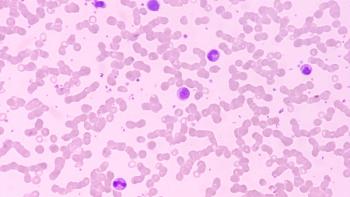
Opinion: Targeted Therapy Plus Immunotherapy Is Promising for ATC
Oncology nurses can encourage clinical trial enrollment for patients with anaplastic thyroid cancer, a rare and aggressive cancer type.
Characterized by rapid tumor growth and a high rate of metastatic disease at the time of diagnosis, anaplastic thyroid cancer (ATC) is one of the most devastating cancer diagnoses that a patient can receive.1 While ATC represents only about 1% of all thyroid cancers, it accounts for nearly 20% of thyroid cancer-related deaths.2 Historically, the median overall survival (OS) for ATC was just 5 months.1
ATC originates from subtypes of differentiated thyroid cancer, typically less aggressive forms such as papillary or follicular thyroid cancers, but it acquires mutations that drive its aggressive behavior. Among these mutations, only the BRAF V600E mutation—present in approximately 40% of ATC cases—is currently actionable. This mutation can be targeted with the FDA-approved combination of dabrafenib and trametinib, which inhibits tumor growth in BRAF V600E-mutated ATC. However, no similarly effective treatments exist for ATC lacking this mutation, highlighting a critical gap in therapeutic options.1
Combining Targeted Therapy and Immunotherapy
Cabanillas et al investigated the efficacy of combining targeted therapy, selected based on a patient’s tumor mutation status, with atezolizumab, a PD-L1 inhibitor. This approach addressed the need for a rapid therapeutic response in ATC, as checkpoint inhibitors typically have a slower onset of action. Additionally, the researchers aimed to overcome resistance to targeted therapy by incorporating immunotherapy, which works through a different mechanism. Their hypothesis was that this combination would improve OS in patients with ATC.1
The study included patients with unresectable, locoregionally advanced ATC and/or distant metastases. Participants were required to have active disease, but measurable target lesions were not necessary. Eligible patients also had to maintain an ECOG performance status of 2 or lower and exhibit adequate organ function. Notably, individuals who had previously undergone treatment with anti-PD1 or PD-L1 therapies were excluded from the trial.
Treatment assignment was determined based on tumor mutation status. Patients with a BRAF V600E mutation were treated with a combination of vemurafenib and cobimetinib with atezolizumab (cohort 1). Those harboring RAS or NF1/2 mutations received cobimetinib plus atezolizumab (cohort 2). For patients without any actionable mutations, the treatment options included either the vascular endothelial growth factor (VEGF) inhibitor bevacizumab plus atezolizumab (cohort 3) or a paclitaxel-based chemotherapy regimen plus atezolizumab, assigned to those with contraindications for VEGF inhibitors (cohort 4).
Before starting the clinical trial, patients were allowed to receive chemotherapy with either paclitaxel or nab-paclitaxel. This initial treatment helped manage and stabilize their disease before transitioning to mutation-driven therapy.
The primary objective of the study was to determine whether the combination of targeted therapy and atezolizumab would enhance OS in patients with ATC compared with historical controls. Secondary objectives focused on overall response rate (ORR), OS, and progression-free survival (PFS) within each treatment cohort.
A total of 43 patients with ATC were enrolled in the clinical trial, with 42 evaluable patients across the cohorts. At the data cutoff, 29 patients (69%) had died, while 13 (31%) were alive. The median OS for all cohorts was 18.23 months (95% CI, 7.79-43.24), with a median follow-up time of 18.97 months (95% CI, 0.43-72.11).
Specifically, cohort 1, which focused on BRAF mutations, had a median OS of 43.24 months (95% CI, 16-not estimable [NE]), whereas cohort 2, addressing RAS and NF1/2 mutations, had a median OS of 8.74 months (95% CI, 5.13-36.96). The ORR was 50% in cohort 1 and 14% in cohort 2.
Notably, treatment led to 12 patients achieving resectable tumors, with 11 undergoing surgery. Of these, 73% remained alive when the study was published.
The trial participants experienced various adverse events (AEs), including one death potentially linked to trial participation due to colon perforation. Several other serious AEs were reported, such as colitis, papilledema from optic nerve neuritis, retinopathy, decreased ejection fraction, pneumonitis, pancreatitis, and esophageal perforation.
Nursing Considerations
Several aspects of this clinical trial make it notable for oncology nurses. For instance, while many trials require measurable disease, which is determined by specific criteria regarding tumor size, this study permitted nonmeasurable disease, potentially expanding treatment options for more patients. Additionally, patients were allowed to receive chemotherapy during the clinical trial screening process, which can take several weeks, due to the aggressive nature of ATC. Typically, patients do not receive other treatments during the screening phase of clinical trials.
Lastly, this trial accommodated patients who had difficulty swallowing, a common symptom of ATC, by allowing medication to be administered in suspension or crushed via a feeding tube. In contrast, many clinical trials exclude patients unable to swallow, including the trial that led to the approval of dabrafenib/trametinib.1
The combination of targeted therapies and immunotherapy in this study represents a promising approach to the treatment of ATC, particularly for patients with actionable mutations such as BRAF V600E. The significant improvement in median OS observed—especially in cohort 1—underscores the potential of this dual treatment strategy to extend life for patients with ATC. Continued research in this area is essential to enhance treatment options and outcomes.
References
- Cabanillas ME, Dadu R, Ferrarotto R, et al. Anti-programmed death ligand 1 plus targeted therapy in anaplastic thyroid carcinoma: a nonrandomized clinical trial. JAMA Oncol. 2024;10(12):1672-1680. doi:10.1001/jamaoncol.2024.4729
- Boucai L, Zafereo M, Cabanillas ME. Thyroid cancer: a review. JAMA. 2024;331(5):425-435. doi:10.1001/jama.2023.26348
Newsletter
Knowledge is power. Don’t miss the most recent breakthroughs in cancer care.



















































































